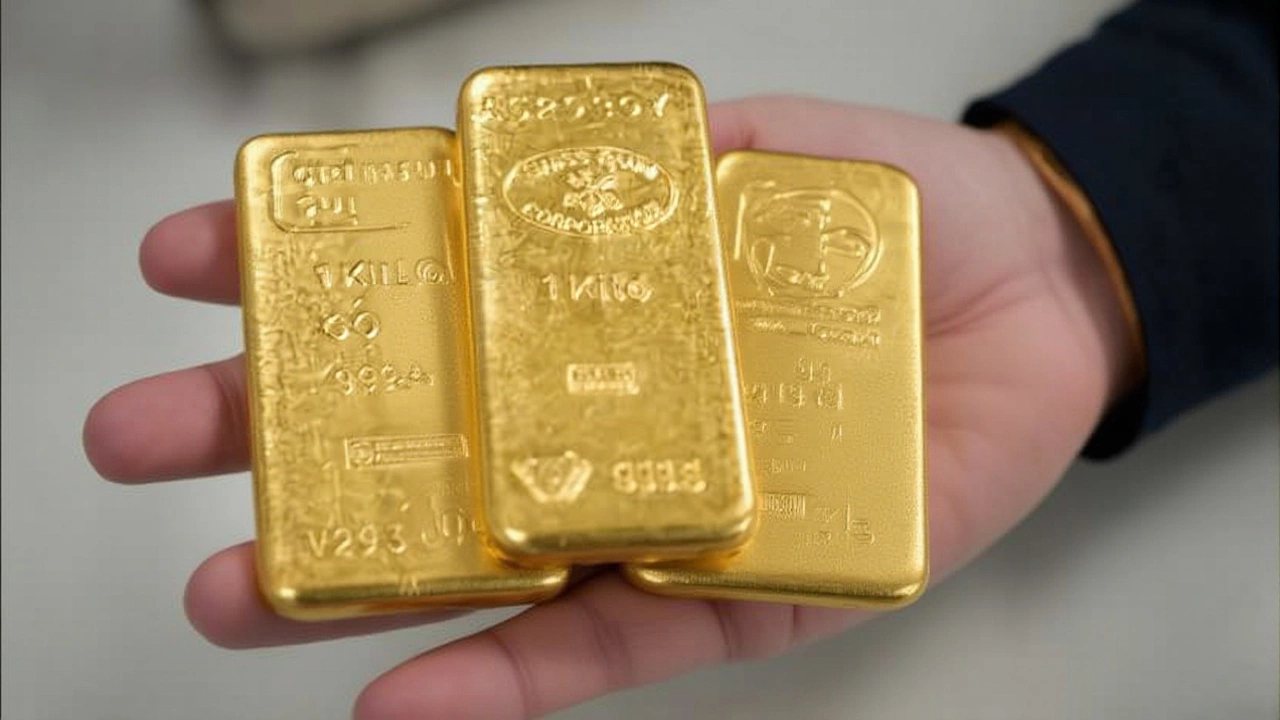Gold prices vaulted past $4,000 per ounce on October 7, 2025, after The Economic Times reported a 97 % probability of a 25‑basis‑point cut by the Federal Reserve later that month. Spot gold settled at $4,011.18, a 0.7 % daily rise that sent market watchers scrambling for explanations. The surge isn’t a flash‑in‑the‑pan anomaly; it caps a 53 % year‑to‑date rally that began in early 2025 and reflects a perfect storm of safe‑haven demand, record ETF inflows and expectations of looser U.S. monetary policy.
Why gold broke the $4,000 barrier
Historically, the $4,000 level has been a psychological ceiling. When the price finally nudged past it, traders whispered about "the $5,000 future"—a sentiment echoed by many on the floor of the London bullion market. The break coincided with a modest bounce in the U.S. dollar, yet the metal kept climbing, underscoring that dollar strength alone can’t stall the current gold frenzy.
The forces behind the rally
Three drivers dominate the narrative. First, geopolitical tension remains high. Ongoing conflicts in the Middle East and Ukraine keep investors reaching for safe‑haven assets. Second, exchange‑traded fund (ETF) inflows have been staggering: globally backed ETFs added 397 metric tons in H1 2025, translating to roughly $38 billion of new capital, according to the October 7 EBC report.
Third, market expectations of a Fed rate cut have hardened. Futures traders are pricing a 25‑basis‑point reduction in October at 97 % confidence, and an 88 % chance of another cut before year‑end. Lower rates cheapen the opportunity cost of holding non‑yielding assets like gold, nudging the metal higher.
What the experts say
“There's so much faith in this trade right now that the market will look for the next big round number, which is 5,000, with the Fed likely to continue to lower rates,” said Tai Wong, independent metals trader based in New York City. Wong added that, “Even if we see a lasting truce in the Mideast or Ukraine, the fundamental drivers—massive debt, reserve diversification, and a weaker dollar—won’t change in the medium term.”
Across the Pacific, Tim Waterer, Chief Market Analyst at KCM Trade in Sydney, echoed the uncertainty thesis: “Rising uncertainty levels tend to fuel gains in the gold price and we are seeing this theme play out again.” He warned, however, that “the temptation to take profits around the $4,000 mark poses a short‑term risk.”
Model forecasts remain split. BullionVault compiled AI‑driven predictions ranging from $3,673 to $3,947 (ChatGPT‑4 Turbo) and a more conservative $2,200‑$3,100 (Gemini). The LBMA’s own average outlook was nudged up to $3,159 for the full year—still below the actual Q3 average of $3,455.50 but a clear sign of upward pressure.

Numbers that tell the story
- Spot gold hit $4,011.18 on Oct 7, 2025 (0.7 % rise).
- U.S. gold futures for Dec 2025 settled at $4,033.40.
- ETF inflows: +397 metric tons, ≈$38 billion in H1 2025.
- Year‑to‑date gold gain: 53 % (vs. 27 % in 2024).
- Probability of an Oct 2025 Fed cut: 97 %.
Looking ahead: risks and opportunities
Analysts at Goldman Sachs and UBS have already upgraded their 2026 gold outlook, citing sustained ETF demand and the prospect of further U.S. rate easing. Yet several headwinds linger. A surprise resolution to the Ukraine war or a rapid fiscal settlement in Washington could lower safe‑haven demand overnight. Additionally, a prolonged U.S. government shutdown may inject volatility into treasury yields, indirectly influencing gold’s appeal.
For retail investors, the key question is timing. The metal’s recent break suggests that any pull‑back could be brief, but profit‑taking around $4,000 is likely. Diversification remains prudent: a balanced exposure to gold alongside silver, platinum and palladium can hedge against sector‑specific shocks.

Key facts
- Spot gold crossed $4,000 for the first time on Oct 6‑7, 2025.
- Fed rate‑cut odds sit at 97 % for a 25‑bp reduction in October.
- Physical gold ETFs added 397 tons in the first half of the year.
- Expert forecasts vary, with the most bullish suggesting a $5,000 target if rate cuts continue.
- Gold’s YTD performance outpaces most equity indices.
Frequently Asked Questions
How might a Fed rate cut affect gold prices in the short term?
A cut lowers the opportunity cost of holding non‑yielding assets, typically pushing gold higher. In October 2025, the market priced a 97 % chance of a 25‑bp cut, which helped lift spot gold above $4,000. If the Fed follows through, we could see another 2‑3 % rally in the weeks after the announcement.
What role are ETFs playing in the current gold surge?
ETFs have funneled roughly $38 billion into physical gold in the first half of 2025, adding 397 metric tons. This inflow not only boosts demand but also creates a feedback loop: higher prices attract more investors, which in turn drives price gains.
Is the $5,000 gold price target realistic?
The $5,000 figure is speculative but not impossible. It hinges on continued Fed easing, persistent geopolitical risk, and sustained ETF inflows. Most mainstream forecasts still sit below $4,500 for 2025, so $5,000 would require a combination of additional catalysts.
What risks could cause gold to retreat from the $4,000 level?
Unexpected de‑escalation of global conflicts, a rapid fiscal resolution in Washington, or a sharp rebound in the dollar could all pressure gold lower. Short‑term profit‑taking around the psychological $4,000 mark is also a near‑term risk highlighted by analysts.
How does gold’s performance compare to other precious metals right now?
Silver rose 1.3 % to $48.42, platinum jumped 2.5 % to $1,658.40, and palladium gained 1.8 % to $1,361.89 on Oct 7. While all metals benefited from the safe‑haven sentiment, gold’s percent gain outpaced the others, reinforcing its premier status.

